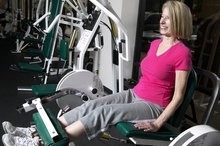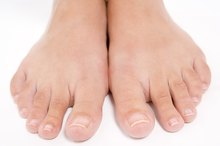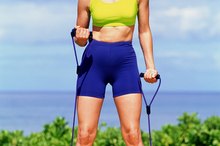How to Increase Circulation in the Arms
A number of factors can compromise circulation throughout your body, including the arms. Periods of inactivity, peripheral artery disease and Raynaud's disease are examples of conditions that can affect the blood flow to your arms and hands. Symptoms of poor circulation in the arms include tingling, numbness and a drop in temperature in the affected extremities. Exercise, lifestyle changes and following a healthy diet can reverse certain medical conditions, and may increase circulation in the arms.
Perform range-of-motion exercises to increase circulation to your arms. Inactivity can cause blood to pool in your arms, causing numbness and tingling in your fingers. Fold your arms in front of you as if you were holding a baby. Rock your arms from one side to the other. Extend your arms at your sides like you are pretending to be an airplane. Slowly make circles with your arms. Try each movement for 10 seconds to start and increase the time incrementally if you can.
How to Lift Weights With Varicose Veins
Learn More
Rotate your wrists in slow circles and wiggle your fingers. These range-of-motion exercises for your hands keeps circulation moving into your fingers. Each exercise should be done for a specified number of seconds or repetitions based on your doctor's orders.
Wear clothing that is loose in the arms and around your wrists. Shirts with tight sleeves or cuffs can impede circulation in your arms, particularly if you have Raynaud's disease, according to MayoClinic.com. Wide or short sleeves are an ideal choice. Removing wrings and watches could also increase your circulation.
How to Improve Inner Ear Circulation
Learn More
Warm your hands with gloves or mittens when suffering from the effects of poor circulation. The protective clothing will not only make you more comfortable, but can help increase circulation. If you do not have gloves handy, put your hands under your arms or massage them to keep them warm and stimulate circulation.
Stop smoking and drinking caffeinated beverages such as tea, coffee and soft drinks. Caffeine and nicotine cause your blood vessels to constrict, or become more narrow. The narrowing of the blood vessels can compromise circulation.
Ask your primary care physician for blood tests to check your cholesterol levels and a CT scan to assess the condition of your blood vessels. High cholesterol, obesity and high blood pressure are all risk factors for arm artery disease, a type of peripheral artery disease in which your blood vessels become clogged with fatty deposits. Exercise and wardrobe adjustments might not be enough to increase arm circulation if you have arm artery disease.
Change your diet to increase circulation throughout your body. A healthy diet low in fat and sodium can normalize your blood pressure and cholesterol levels, which reduces your risk of artery disease and the associated circulation problems. Eat plenty of fresh fruit and vegetables, whole grains and low-fat dairy products while limiting red meats and fried foods. Always consult your doctor, however, before starting a new diet.
Take medications as prescribed by your doctor. You might require medicine to lower your blood sugar or control your blood pressure as you are putting lifestyle modifications into place. Your doctor might also prescribe a vasodilator drug, a type of medication that helps the blood vessel walls relax to increase circulation.
Related Articles
References
- MayoClinic.com: Cold Hands
- The Ohio State University Wexner Medical Center: Arm Artery Disease
- The Ohio State University Medical Center: Self-Range of Motion Exercises for Shoulders, Arms, Wrists, Fingers
- MayoClinic.com: Raynaud's Disease: Lifestyle and Home Remedies
- MayoClinic.com: Nutrition and Healthy Eating
Writer Bio
Erica Roth has been a writer since 2007. She is a member of the Society of Professional Journalists and was a college reference librarian for eight years. Roth earned a Bachelor of Arts in French literature from Brandeis University and Master of Library Science from Simmons College Graduate School of Library and Information Science. Her articles appear on various websites.









